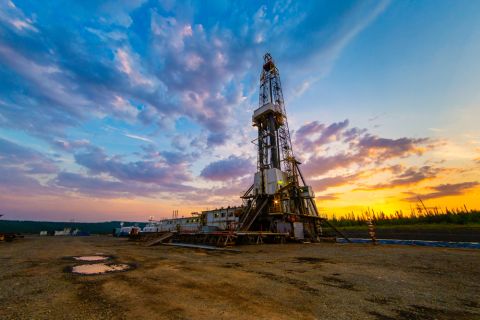As the U.S. economy was showing signs of a slow-down toward the end of 2000, unclear is whether more than a year of higher gasoline and natural-gas prices is the biggest reason why. The single point on which several economists agree is that the consequences of sustained, high fuel prices are not as dire today as they proved to be in the 1970s. John H. Lichtblau, chairman of Pira Energy Associates in New York, remembers what it was like. "In 1978, it was incorrectly assumed that prices would stay high. Now, everyone expects prices to be below $30 per barrel in 2001 and 2002. They assume that more oil will come from somewhere and there will be some reaction on the demand side to high prices." There also is much more money to drill wells now, he adds. Producers have not spent nearly as much money as they could, and they will put more of it into their upstream businesses now. This does not mean that oil industry leaders aren't concerned. "In a lot of ways, we're looking at a fourth energy crisis, one that's different from the last three, which were driven by military and political events," observes Paul W. Chellgren, chairman and chief executive officer of Ashland Inc. "It's much more complex. The crude oil is available, although at higher prices. But it's almost as if every part of the delivery system has started to break down after years of low investment, because returns have been so badly depressed. This involves more than petroleum products. Natural gas and electricity also face potential problems." John Felmy, chief economist at the American Petroleum Institute in Washington, says the entire U.S. energy system is feeling pressure. "We're suffering from decades of energy infrastructure neglect," he says. "In the oil industry, we don't produce as much crude oil and have lower distillation capacity at our refineries. We produce 3 trillion cubic feet less of natural gas annually than we did 30 years ago. And if an electric power producer has problems with one of its nuclear or coal-fired plants, that cascades into natural gas as well." There is also pressure downstream: there has been no new domestic refinery construction in 25 years. U.S. crude-oil processing capacity has kept pace through debottlenecking and other projects at existing installations, but there is some concern that this may be near its limit. "We're struggling to make enough products to satisfy demand, but we're running refineries at peak utilization, so we've had to increase product and crude imports," Felmy says. "These matters haven't been addressed yet. If this country is going to continue to grow, it will need to have the energy to do so." Consumers did not seem worried last month, as winter approached. Complaints about high gasoline prices had receded by midsummer, and most families went ahead with their scheduled vacations. "Consumers apparently think that this is transitory. They have been spending through it, on larger vehicles and on travel," says Diane Swonk, chief economist at Bank One in Chicago. "We had a reacceleration in consumer spending during the summer as fuel prices were going up. That was a real difference from the 1980s, when there was talk that oil prices could reach $100 per barrel and producers of industrial goods were bracing themselves for an economy where oil would eat up a large amount of their ability to spend. The question now is, When will consumers start to view high oil prices as a permanent, instead of a transitory, event?" The biggest single difference? The U.S. economy is much less dependent on energy than it was 20 years ago. Felmy says, "If you look at the peak role that oil costs played in 1981, the real oil bill divided by real gross domestic product was more than 8%. Now, it's less than 3%. Real oil prices have declined substantially. "Second, we're a lot more efficient. Oil is a small share of doing business. In real terms, we would need prices to be at least $80 per barrel to have the kind of impact we saw back then." The drive to use energy more efficiently in the early 1980s was a clear response to two significant oil supply shocks during the 1970s, according to Sarah Emerson, managing director at Energy Security Analysis Inc. in Boston. "We quit relying on fuel oil to generate electricity, for example," she says. "Now, our oil demand is oriented less toward manufacturing and more toward transportation. That means that we can cope with higher oil prices to a much greater degree than we could 20 years ago." Also, the U.S. economy is significantly stronger now than it was in the 1970s. "Of the inflation acceleration we've seen in the past year, maybe a quarter-percent is due to higher oil prices," Swonk says. "Most of that is spillover in the form of higher airline ticket prices and higher costs to transport goods. But it's nowhere near as great as in the 1970s and '80s." Stephen P.A. Brown, director of energy economics and microeconomic policy analysis in the research department at the Federal Reserve Bank of Dallas, says that continued strong oil prices result from increasing global demand, especially in emerging economies like China and Korea. "Because the demand of a strong economy is pulling energy prices upward, those higher prices are less likely to slam the stronger economy. It's likely that they will constrain growth eventually. But they don't seem likely to plunge us into a recession." If West Texas Intermediate continues to average around $35 per barrel, the U.S. GDP could be between 0.2% and 0.5% lower than if the price fell to $25, which is the price that is expected next year by some analysts. Such a reduction would be noticeable in an economy that was growing 3.5% to 4% annually, Brown says. But it would be more of a restraint than a reversal and, in some quarters, might not even be noticed. Brown recommends looking beyond core inflation measurements that exclude energy prices, to broader indicators, such as the full consumer price index. "When we do, we find that the overall CPI has been rising more rapidly than the core," he explains. "Much of that is rising energy prices. We take energy and food out to create a measure that is more stable and try to abstract it from temporary supply effects. But if energy prices are rising as a result of strong demand, it's really not appropriate to take it out of our inflation measurement." The higher price of natural gas raises a different question, however. Swonk believes it may be the U.S. economy's Achilles heel. "The question is timing and whether the effect is permanent or transitory." Natural gas prices, in nominal terms, are at their highest. In real prices, they're about where they were in the early 1980s, says Brown. A cold or normal winter would boost demand and put a lot of pressure on natural gas prices. Part of the gas-price pressure eventually could be relieved by increased domestic production. Felmy points out that about 800 of the more than 1,000 U.S. rigs at work in late 2000 were drilling for gas. "We've been fortunate in being able to import 3 trillion cubic feet per year from Canada," he says. "But we also believe that the U.S. government needs to step back and address a contradiction in its energy policy. It wants to see more natural gas used because it is clean burning. But it also has put significant areas off limits to exploration and development." Nevertheless, economists expect energy demand growth worldwide to at least slow down if energy prices stay high. "I expect to see it come off somewhat during the next six to 12 months as supply adjusts to consumption," Swonk indicates. "Countries like Brazil that depend on oil imports will be hurt, and its demand will drop." Emerson notes, "On one hand, the economy is less dependent on oil because it has moved from heavy industry to technology. On the other hand, higher oil prices still can have an impact." Truckers and industries pass higher costs on to consumers. "Gasoline consumption is the area where we've seen the most demand response to price. People still drive to work when prices go up, but they gradually begin to change their behavior over a sustained period. Instead of going to the grocery store three times a week, they go only once and plan ahead. They start to carpool. "My guess is that we'll only fully understand the impact of higher prices later in 2001 when hard demand data are available for the second half of 2001. That will be reflected in lower gross national product growth." Swonk says, "We still have an exceptionally strong economy, where employment is high. Corporate restructuring continues but unlike the early 1990s, there's some place for laid-off employees to land now. We might get a temporary squeeze, but I don't think many people are talking about that. The outlook is significantly more optimistic on Main Street. There are a lot more of those in this country than Wall Streets."
Recommended Reading
Betting on the Future: Chevron Technology Ventures’ Investment Strategy
2024-04-09 - After a quarter century, Chevron Technology Ventures seeks both incremental and breakthrough technologies with its early-stage investment program.
Haynesville’s Harsh Drilling Conditions Forge Tougher Tech
2024-04-10 - The Haynesville Shale’s high temperatures and tough rock have caused drillers to evolve, advancing technology that benefits the rest of the industry, experts said.
CERAWeek: Large Language Models Fuel Industry-wide Productivity
2024-03-21 - AI experts promote the generative advantage of using AI to handle busywork while people focus on innovations.
Tech Trends: Autonomous Drone Aims to Disrupt Subsea Inspection
2024-01-30 - The partners in the project are working to usher in a new era of inspection efficiencies.
Drilling Tech Rides a Wave
2024-01-30 - Can new designs, automation and aerospace inspiration boost drilling results?





